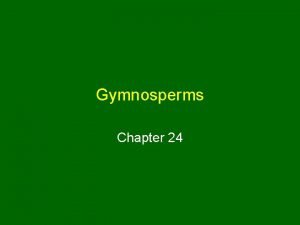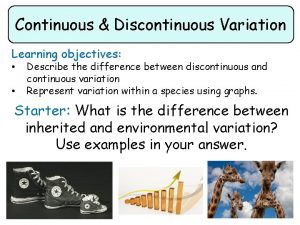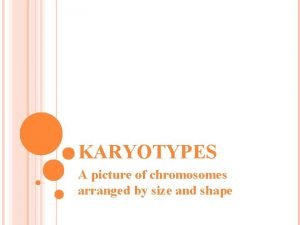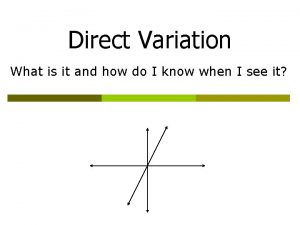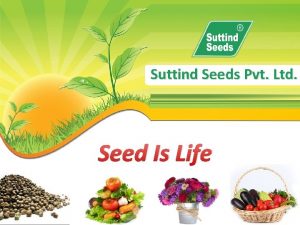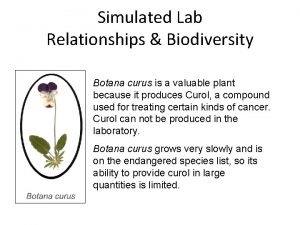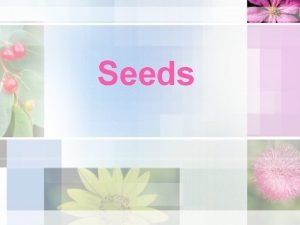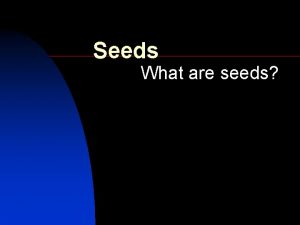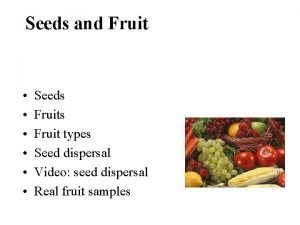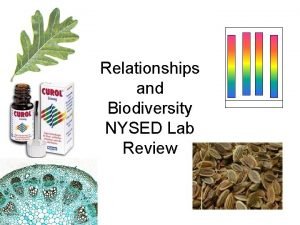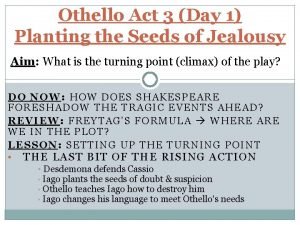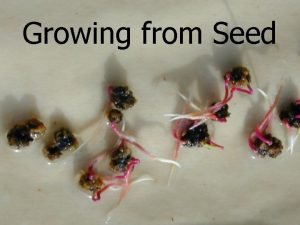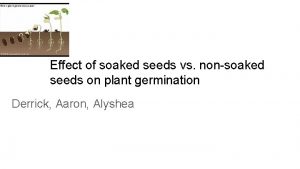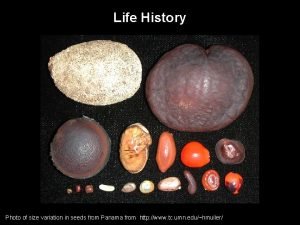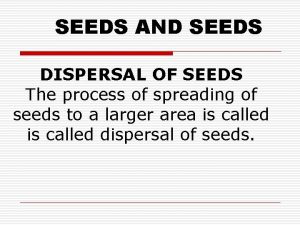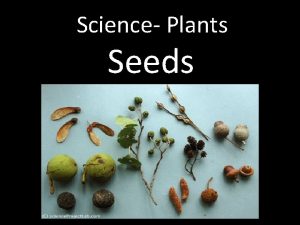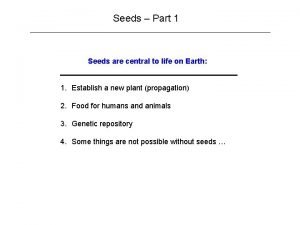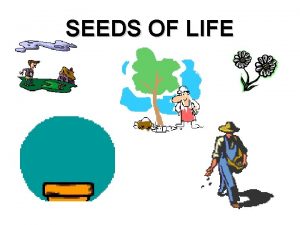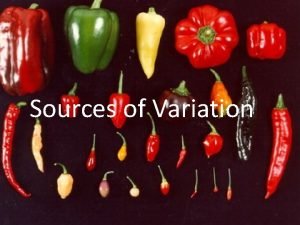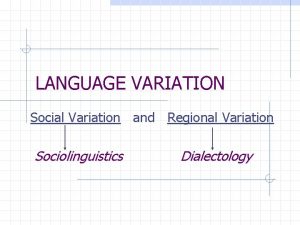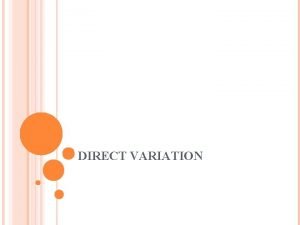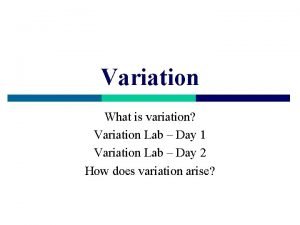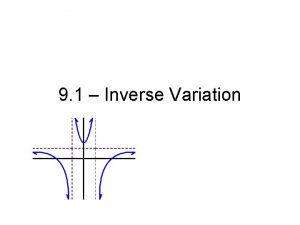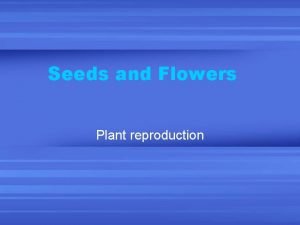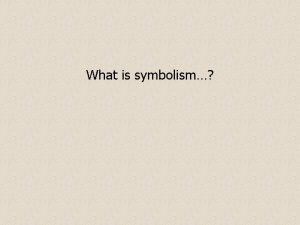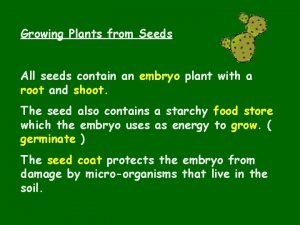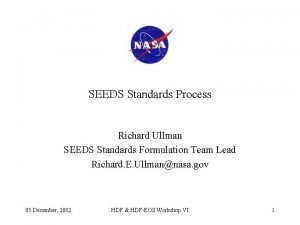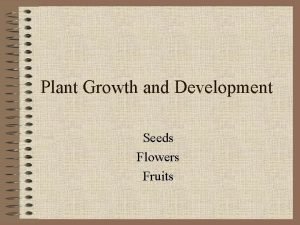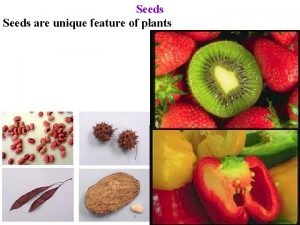Life History Photo of size variation in seeds


























- Slides: 26

Life History Photo of size variation in seeds from Panama from http: //www. tc. umn. edu/~hmuller/

Life History Major events related to an organism’s growth, development, reproduction & survival Timing, duration, phenology, rate, allocation, allometry, etc. shaped by natural selection Life-history traits vary among individuals & populations Wood duck w/ 5 Wood duck w/ 7 Mallard w/ 11 Life-history strategy is a population-level representation Photos from: http: //westboroughlandtrust. org/nn/nn 54. php; http: //portlandbirds. blogspot. com/2010_05_01_archive. html; http: //www. rampantscotland. com/colour/supplement 070519. htm

Asexual vs. sexual reproduction Binary fission produces genetically identical clones Protozoan Paramecium Image from http: //biodidac. bio. uottawa. ca/thumbnails/filedet. htm? File_name=OLIH 023 P&File_type=GIF

Asexual vs. sexual reproduction Sexual reproduction produces genetically variable offspring Isogamous gametes Anisogamous gametes Bowman, Hacker & Cain (2017), Fig. 7. 8 Alga Chlamydomonas Homo sapiens

Asexual vs. sexual reproduction A “cost of sex” / “cost of males” Assume each adult female in a population produces 4 offspring, either asexually or sexually Bowman, Hacker & Cain (2017), Fig. 7. 9

Asexual vs. sexual reproduction Benefit of sex: Genetic variation E. g. , Red Queen Hypothesis (coping with ever-evolving enemies) From a statement the Red Queen makes to Alice in Lewis Carroll’s “Through the Looking Glass” (“Alice in Wonderland”): “Now, here, you see, it takes all the running you can do, to keep in the same place” Photo of harvestman with parasitic mites from Wikimedia Commons

Simple vs. complex life cycles Complex life cycle – 2 or more distinct stages that differ in habitat, physiology, or morphology E. g. , Alternation of Generations in plants E. g. , Holometabolous insects Larval, pupal & adult wasps E. g. , Anadromous & catadromous fishes Anadromous salmon adults live at sea, but spawn in freshwater E. g. , Metamorphic amphibians Photos from Wikimedia Commons Herbivorous, aquatic tadpole will become carnivorous, terrestrial adult

Ontogenetic niche shifts Occur routinely in organisms with complex life cycles, but occur in other organisms as well Aquatic larva Winged adult Photo of hellgrammite (larva) and adult Dobson flies (Order Megaloptera) from Wikimedia Commons

The Life Cycle of Animals – Illustrated for Humans Generation 1 Generation 2 Specialized cells undergo meiosis to produce gametes Gametes fuse during fertilization to become a zygote AA XX Gen. 3 A X Aa XX AA XY a X A Y Aa XY a X From the single-celled zygote stage onward, cells undergo mitosis to increase the number of cells in the maturing individual. Aa XX Multicellular individuals; Diploid (2 n) cells Aa XY Unicellular gametes; Haploid (1 n) cells Unicellular zygote; Diploid (2 n) cell Muticellular individuals; Diploid (2 n) cells

The Life Cycle of Fungi – Illustrated for Bread Mold Several generations Multiple rounds of asexual reproduction possible; all cell divisions occur by mitosis. A + Multiple rounds of asexual reproduction possible; all cell divisions occur by mitosis. Brief intergenerational zygote stage Several generations Zygotic meiosis Aa a +- - Fusion of compatible hyphae (plasmogamy and karyogamy) to form a zygote-like structure a - Multiple rounds of asexual reproduction possible; all cell divisions occur by mitosis. a - Haploid (1 n) cells of hyphae Multiple rounds of asexual reproduction possible; all cell divisions occur by mitosis. a + Diploid (2 n) zygote Haploid (1 n) spore Haploid (1 n) cells of hyphae

The Life Cycle of Plants (Alternation of Generations) – Illustrated for a Dioecious Flower Generation 1 Specialized cells undergo meiosis to produce spores AA bb A b Gen. 4 Generation 3 Generation 2 Gametes fuse during fertilization to become a zygote Pollen grain aa BB A b Aa Bb a B Aa Bb Multicellular sporophyte Diploid (2 n) cells Embryo sac A b Aa Bb a B Single-celled spores undergo mitosis to increase the number of cells in the maturing gametophyte. Mature gametophyte produces gametes by mitosis Unicellular spores Multicellular gametophyte Haploid (1 n) cells a B Unicellular gametes Specialized cells undergo meiosis to produce spores Unicellular zygote Multicellular sporophyte Diploid (2 n) cells Unicellular spores of gametophyte Haploid (1 n) cells

Allocation Trade-offs, Costs & Benefits, Constraints Resources vs. Photos from Wikimedia Commons

Allocation Trade-offs, Costs & Benefits, Constraints Resources vs. Photos from Wikimedia Commons

Allocation Trade-offs, Costs & Benefits, Constraints Resources vs. Photos from Wikimedia Commons

Allocation Trade-offs, Costs & Benefits, Constraints There is no free lunch A jack of all trades is master of none E. g. , offspring or propagule size-number tradeoff Number Size Each dot represents the life-history strategy of a given species in a given clade

Allocation Trade-offs, Costs & Benefits, Constraints Constraint lines and wedge-shaped distributions Number Size Each dot represents the life-history strategy of a given species in a given clade

Allocation Trade-offs, Costs & Benefits, Constraints Consider 100 g resources that could be divided among seeds (offspring) 12 10 8 6 4 2 0 0. 00 Log 10(Number) vs. Log 10(Size) Log 10(Number) Number vs. Size 20. 00 40. 00 60. 00 Size 80. 00 100. 00 120. 00 See Excel file: Life. History. Tradeoff. xlsx 1. 20 1. 00 0. 80 0. 60 0. 40 0. 20 0. 00 0. 50 1. 00 1. 50 Log 10(Size) 2. 00 2. 50

Design Trade-offs, Costs & Benefits, Constraints Design: shape, function, etc. vs. Photos from Wikimedia Commons

Design Trade-offs, Costs & Benefits, Constraints A jack of all trades is master of none E. g. , consider pond-breeding salamander species in ephemeral pools vs. stable ponds What life-history strategy would perform best in each habitat? Is there a “one size fits all” solution?

Semelparous vs. Iteroparous (Monocarpic vs. Polycarpic) Often entails a reproduction – survival tradeoff Monocarpic talipot palm Polycarpic coconut palm Photo of monocarpic talipot palm from http: //www. etawau. com/Agriculture/Index. Trees. htm; photo of polycarpic coconut palm from http: //www. hawaii. edu/cpis/MI/plants/ni. html

r-selected vs. K-selected General environmental or population-level correlates Disturbance Population growth rate Stability K-selected “Slow & steady” r-selected Correlated organismal traits Body size Life span Parental investment in offspring Developmental rate Rate of maturation Reproductive rate The concepts of r-selection & K-selection originated with Mac. Arthur & Wilson (1967) “Live fast, die young”

Grime’s Triangular Model Competitive (C) – most similar to K-selected species Stress-tolerant (S) Ruderal (“weedy”) (R) – most similar to r-selected species Competition = “tendency of neighboring plants to utilize the same quantum of light, ion of a mineral nutrient, molecule of water, or volume of space” Disturbance = “process that destroys plant biomass” Stress = “abiotic factor that limits vegetative growth” Image from http: //hosho. ees. hokudai. ac. jp/~tsuyu/top/dct/lc. html; original concept from Grime (1977) American Naturalist

Grime’s Triangular Model An example in corals Darling et al. (2012) Ecology Letters

Competition – Colonization Tradeoff Colonization Ability Competitive Ability The concept was elaborated by Rees & Westoby (1997) Oikos

A Classic Example: Clutch Size David Lack “Lack Clutch Size” = clutch size that maximizes the number of offspring that a parent can rear to maturity, given the tradeoff between investment per offspring vs. number of offspring Experimental evidence through clutch-size manipulation experiments Original concept from Lack (1947) Ibis

A Classic Example: Clutch Size David Lack “Lack Clutch Size” = clutch size that maximizes the number of offspring that a parent can rear to maturity, given the tradeoff between investment per offspring vs. number of offspring Experimental evidence through clutch-size manipulation experiments Figure from https: //www. nature. com/scitable/knowledge/library/life-history-evolution-68245673
 Why are gymnosperm seeds referred to as “naked seeds”?
Why are gymnosperm seeds referred to as “naked seeds”? Direct variation constant of variation
Direct variation constant of variation Direct and inverse variation graphs
Direct and inverse variation graphs How to calculate sst in regression
How to calculate sst in regression Continuous variation graph
Continuous variation graph Japanese visa photo size
Japanese visa photo size A display of the chromosomes arranged by size
A display of the chromosomes arranged by size Direct variation table
Direct variation table Const char *s
Const char *s Brushing method in size separation
Brushing method in size separation How to scarify kentucky coffee tree seeds
How to scarify kentucky coffee tree seeds Suttind seeds pvt ltd
Suttind seeds pvt ltd Is botana curus real
Is botana curus real Two types of seeds
Two types of seeds 3 parts of seeds
3 parts of seeds Two types of seeds
Two types of seeds Botana curus leaf
Botana curus leaf A windstorm blows in hundreds of seeds from a nearby meadow
A windstorm blows in hundreds of seeds from a nearby meadow Role of transpiration
Role of transpiration It is the result of activism in 1972
It is the result of activism in 1972 Draw a bean seed and label its parts
Draw a bean seed and label its parts How seeds spread
How seeds spread Othello falling action
Othello falling action Foreshadowing in othello
Foreshadowing in othello How seeds travel worksheet
How seeds travel worksheet Seeds are matured
Seeds are matured Conclusion of seed
Conclusion of seed
